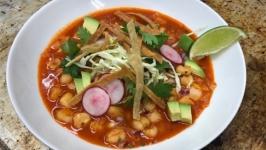Speckled Hound, Long Island Cheese and Hubbard
What do Speckled Hound, Long Island Cheese and Hubbard have in common? Nursery rhymes? Canine species? Insults? They are, in fact, pumpkin varieties.
Idaho cultivates an abundance of pumpkins. When asked what variety is an Idaho specialty, Josie Erskine of Peaceful Belly Farms outside Boise says "anything grows here." But Erskine does have a favorite: Winter Luxury Pie. Like its name says, it's a pie pumpkin: sweet, with creamy flesh and less water than most pumpkins. Amy Goldman, author of the definitive The Compleat Squash, insists that the Winter Luxury variety is so rich that you will need less sugar and fewer eggs in your pie. (What if you enjoy more sugar and eggs?)
Aside from carving jack-o-lanterns, making pies and chucking them off rooftops, many people have no idea what to do with pumpkins. Most Americans even use canned pumpkin for their pumpkin pies. Erskine believes there's a general misconception that it's difficult not only to cook pumpkin but also to figure out what to do with the leftovers that didn't go into your pie.
"We lost our ability to eat squash somewhere along the way," says Erskine. "We are the generation that didn't need to eat squash. Squash had become, as she puts it, "poor people's food." The two main reasons for that are that pumpkins are easy to grow and you can store them for months. But times have changed: no matter our economic circumstances, we as a culture have become more food conscious and therefore more squash conscious. "Now it's a rich person's food because you have to have time to cook it," she says.
To many, it's a surprise that pumpkins are super easy to cook.
The best way to extract the flesh from a pumpkin is simply to hack it down the middle, scoop out the seeds with an ice cream scoop and bake the gourd face down in a 350 degree oven for about an hour. It's ready when the flesh is fork tender. You just scoop it out or peel away the rind when it's cool enough and then puree. You could also microwave or steam it.
And what to do with the leftovers?
• Mix pumpkin puree with a can of tomato sauce for pasta sauce
• Put pumpkin puree into your morning oatmeal
• Mix roasted pumpkin with potatoes or sweet potatoes and onions to create a mash
• Make pumpkin bread
• Create casseroles (rice, cheese, vegetable, pumpkin)
• Make pumpkin soups
If you're going to cook with an actual pumpkin, you're not going to use the kind that you carve into a jack-o-lantern. Those pumpkins don't have a lot of meat and are stringy and watery. Find a local grower and ask them how they cook their pumpkins, and which are best for a particular dish. Farmers have the kind of self-evident recipes that make you wonder why you never thought of them: simple, straightforward and delicious.
Don't forget the pumpkin seeds! Pumpkin seeds are rich in antioxidant carotenoids, healthy omega-3 fats and fiber. If you boil them in salted water for ten minutes before you roast them, they will be perfectly crunchy and delicious.







